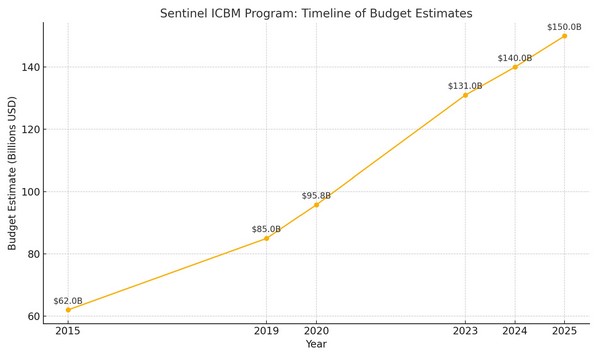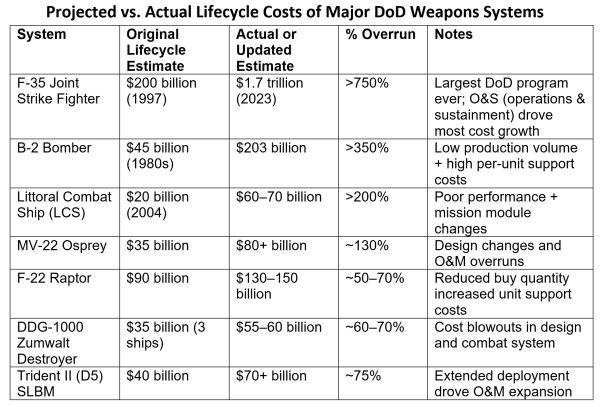There are 400 nuclear missile silos within the central United States that represent the land-based part of the U.S. nuclear deterrent. The Minuteman III missiles within the silos are roughly 50 years previous. Though they’ve been repeatedly upgraded through the years, the Air Power determined a alternative ought to be developed. The brand new missile below growth, the Sentinel, has changed into a traditional case of a mismanaged weapons program.
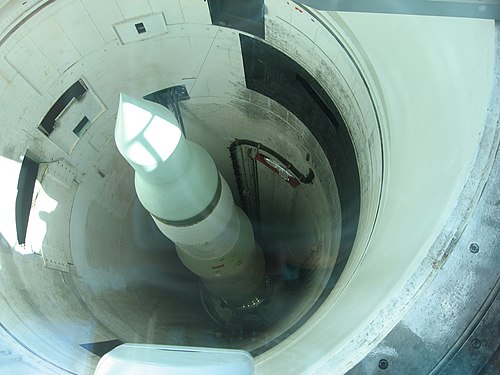
Minuteman missile in silo – time to retire?
The preliminary idea of the Sentinel missile program was to immediately change the Minuteman III missiles within the current launch silos. By reusing the silos, the challenge was made price aggressive with the choice of one other life extension for Minuteman or a swap to a cell missile idea. Though at the beginning Boeing and Northrup Grumman competed for the contract, Boeing withdrew in 2019 and Northrop grew to become the only real bidder. Projected prices started to climb sharply after this level and in January, 2024, the Air Power notified Congress that the Sentinel program’s prices had exceeded baseline projections by greater than 25%, constituting a vital Nunn-McCurdy price restrict breach. This breach mandated a proper assessment and certification course of to find out whether or not this system ought to proceed.
In July of 2024, the Division of Protection accomplished its Nunn-McCurdy assessment. The Underneath Secretary of Protection for Acquisition and Sustainment licensed that the Sentinel program met the required standards to proceed. Nonetheless, he rescinded this system’s Milestone B approval and directed a restructuring to deal with price overruns and administration points. It stays to be seen whether or not Northrup Grumman will make substantial adjustments to curtail the price of this system.
Digging for {Dollars}
Essentially the most exceptional growth in the middle of the runaway price estimates for the Sentinel missile is the latest resolution to construct new silos as a substitute of reusing the present ones. In Might 2025, the U.S. Air Power introduced that the Sentinel ICBM program would require the development of totally new missile silos, including billions to the price of the challenge. This resolution was made after assessments revealed that the ageing Minuteman III silos, some approaching 100 years previous by the tip of Sentinel’s anticipated service life, couldn’t be adequately tailored for the brand new missiles. Elements resembling structural degradation and the necessity for intensive modernization have been the idea of the dedication that constructing new silos was extra sensible and cost-effective than retrofitting the previous ones.
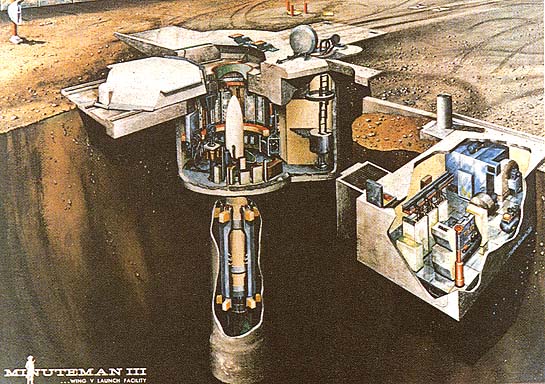
Minuteman silo complicated – too arduous to repair?
Asserting that “structural degradation” has occurred in bolstered concrete constructions designed to outlive a near-miss by a nuclear weapon is puzzling to say the least. Furthermore, the notion that trendy fiber optic linked management infrastructure couldn’t be retrofitted in constructions accommodating far bulkier analog cabling and previous digital techniques is extremely questionable. As well as, there’s a elementary concern relating to silo building: trendy nuclear missiles are correct sufficient to destroy even probably the most robustly constructed silo. The accuracy of ICBMs is now inside 30-50 meters of a goal. There is no such thing as a possible silo design that may survive a close to hit (inside 100-200 meters) by a contemporary earth-penetrating nuclear warhead. This makes makes an attempt to enhance on the hardening of current silos pointless. The survivability of missile silos is now largely a fable sustained by institutional inertia and protection contracting incentives.
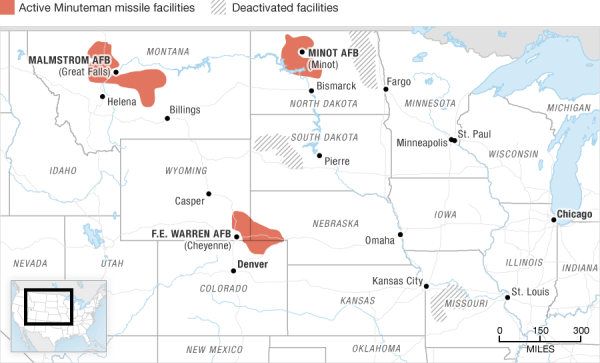
Minuteman missile web site areas
The Mischievous Magic of Nuclear Deterrence
Maybe the best boon conferred on the protection trade by the nuclear period is the elusive idea of deterrence. Like Schrodinger’s cat, it exists concurrently in two contradictory states. It’s all the time completely very important, but perennially inadequate. Its advocates keep that it’s working faultlessly as a result of we now have been spared nuclear assault, whereas concurrently sustaining that we’re in imminent hazard of shedding deterrence until we spend massive sums to protect it. The magical property of deterrence is that there is no such thing as a measurable connection between cash spent on deterrence and the corresponding quantity of deterrence secured. It’s because deterrence exists within the minds of potential attackers, whose psychology is unknown and unknowable. But deterrence is deemed so necessary that it features as a significant justification for any new nuclear weapons program. The deterrence argument has grow to be a fountain of riches for the makers of strategic nuclear weapons.
Magical enthusiastic about deterrence is abundantly displayed within the doubtful design selections of the Sentinel missile program. Initially supposed as a easy alternative for the ageing Minuteman III land based mostly missiles, Sentinel has changed into a runaway weapons program, with projected prices enormously exceeding preliminary estimates. Sentinel program advocates invoke the magic of deterrence as justification for each pricey function added to the missile. They argue {that a} greater payload, longer vary, and extra survivable silos will all add to deterrence, so why ought to we quibble over one other hundred billion {dollars}?
Improvement Danger vs. Improvement Grift
There’s a authentic argument for accepting threat in weapons growth if the objective is a quantum leap in functionality. The event of stealthy fight plane offered a measurable army benefit over potential adversaries, and thus price and schedule overruns of those applications might be defended to some extent. Nonetheless, the Sentinel program, like a number of different mismanaged U.S. weapons applications, doesn’t ship a big new functionality however supplies doubtful “enhancements” at huge expense. Protection contractors, army leaders, and politicians all have incentives to overstate the worth of such applications and understate their prices, figuring out that when began the momentum of a giant weapons challenge is difficult to cease. This drawback doesn’t finish with the event of the weapon. The grift that retains on giving is the lifecycle price, the price of supporting a weapon system throughout its operational lifetime. This price can also be chronically underestimated, and the principle beneficiary is once more the protection contractor. There’s motive to consider that Sentinel will comply with this sample and have lifecycle prices exceeding present estimates of $250-$300 billion.
Conclusion
The Sentinel missile program is one more mismanaged U.S. weapons program exhibiting the persistent flaws of a procurement system distorted by perverse vendor incentives and failed governmental oversight. The Secretary of Protection ought to instantly order adjustments to the Sentinel missile program to make the most of the present Minuteman launch infrastructure, with minimal required modifications of current amenities. Since no silos can survive assault by trendy ICBMs, constructing new silos would enormously inflate the price of this system whereas including little operational functionality. The willingness of the present Protection Secretary to make these adjustments will likely be a check of the Trump administration’s seriousness in eliminating waste in authorities operations. If the Protection Division doesn’t act to include the price of this program, Congress ought to make continued funding contingent on implementing a sound design method based mostly on an impartial assessment by specialists outdoors the affect of the Pentagon and the contractor. Northrup Grumman ought to heed some frequent sense recommendation: If you end up in a gap, cease digging.
There are 400 nuclear missile silos within the central United States that represent the land-based part of the U.S. nuclear deterrent. The Minuteman III missiles within the silos are roughly 50 years previous. Though they’ve been repeatedly upgraded through the years, the Air Power determined a alternative ought to be developed. The brand new missile below growth, the Sentinel, has changed into a traditional case of a mismanaged weapons program.

Minuteman missile in silo – time to retire?
The preliminary idea of the Sentinel missile program was to immediately change the Minuteman III missiles within the current launch silos. By reusing the silos, the challenge was made price aggressive with the choice of one other life extension for Minuteman or a swap to a cell missile idea. Though at the beginning Boeing and Northrup Grumman competed for the contract, Boeing withdrew in 2019 and Northrop grew to become the only real bidder. Projected prices started to climb sharply after this level and in January, 2024, the Air Power notified Congress that the Sentinel program’s prices had exceeded baseline projections by greater than 25%, constituting a vital Nunn-McCurdy price restrict breach. This breach mandated a proper assessment and certification course of to find out whether or not this system ought to proceed.
In July of 2024, the Division of Protection accomplished its Nunn-McCurdy assessment. The Underneath Secretary of Protection for Acquisition and Sustainment licensed that the Sentinel program met the required standards to proceed. Nonetheless, he rescinded this system’s Milestone B approval and directed a restructuring to deal with price overruns and administration points. It stays to be seen whether or not Northrup Grumman will make substantial adjustments to curtail the price of this system.
Digging for {Dollars}
Essentially the most exceptional growth in the middle of the runaway price estimates for the Sentinel missile is the latest resolution to construct new silos as a substitute of reusing the present ones. In Might 2025, the U.S. Air Power introduced that the Sentinel ICBM program would require the development of totally new missile silos, including billions to the price of the challenge. This resolution was made after assessments revealed that the ageing Minuteman III silos, some approaching 100 years previous by the tip of Sentinel’s anticipated service life, couldn’t be adequately tailored for the brand new missiles. Elements resembling structural degradation and the necessity for intensive modernization have been the idea of the dedication that constructing new silos was extra sensible and cost-effective than retrofitting the previous ones.

Minuteman silo complicated – too arduous to repair?
Asserting that “structural degradation” has occurred in bolstered concrete constructions designed to outlive a near-miss by a nuclear weapon is puzzling to say the least. Furthermore, the notion that trendy fiber optic linked management infrastructure couldn’t be retrofitted in constructions accommodating far bulkier analog cabling and previous digital techniques is extremely questionable. As well as, there’s a elementary concern relating to silo building: trendy nuclear missiles are correct sufficient to destroy even probably the most robustly constructed silo. The accuracy of ICBMs is now inside 30-50 meters of a goal. There is no such thing as a possible silo design that may survive a close to hit (inside 100-200 meters) by a contemporary earth-penetrating nuclear warhead. This makes makes an attempt to enhance on the hardening of current silos pointless. The survivability of missile silos is now largely a fable sustained by institutional inertia and protection contracting incentives.

Minuteman missile web site areas
The Mischievous Magic of Nuclear Deterrence
Maybe the best boon conferred on the protection trade by the nuclear period is the elusive idea of deterrence. Like Schrodinger’s cat, it exists concurrently in two contradictory states. It’s all the time completely very important, but perennially inadequate. Its advocates keep that it’s working faultlessly as a result of we now have been spared nuclear assault, whereas concurrently sustaining that we’re in imminent hazard of shedding deterrence until we spend massive sums to protect it. The magical property of deterrence is that there is no such thing as a measurable connection between cash spent on deterrence and the corresponding quantity of deterrence secured. It’s because deterrence exists within the minds of potential attackers, whose psychology is unknown and unknowable. But deterrence is deemed so necessary that it features as a significant justification for any new nuclear weapons program. The deterrence argument has grow to be a fountain of riches for the makers of strategic nuclear weapons.
Magical enthusiastic about deterrence is abundantly displayed within the doubtful design selections of the Sentinel missile program. Initially supposed as a easy alternative for the ageing Minuteman III land based mostly missiles, Sentinel has changed into a runaway weapons program, with projected prices enormously exceeding preliminary estimates. Sentinel program advocates invoke the magic of deterrence as justification for each pricey function added to the missile. They argue {that a} greater payload, longer vary, and extra survivable silos will all add to deterrence, so why ought to we quibble over one other hundred billion {dollars}?
Improvement Danger vs. Improvement Grift
There’s a authentic argument for accepting threat in weapons growth if the objective is a quantum leap in functionality. The event of stealthy fight plane offered a measurable army benefit over potential adversaries, and thus price and schedule overruns of those applications might be defended to some extent. Nonetheless, the Sentinel program, like a number of different mismanaged U.S. weapons applications, doesn’t ship a big new functionality however supplies doubtful “enhancements” at huge expense. Protection contractors, army leaders, and politicians all have incentives to overstate the worth of such applications and understate their prices, figuring out that when began the momentum of a giant weapons challenge is difficult to cease. This drawback doesn’t finish with the event of the weapon. The grift that retains on giving is the lifecycle price, the price of supporting a weapon system throughout its operational lifetime. This price can also be chronically underestimated, and the principle beneficiary is once more the protection contractor. There’s motive to consider that Sentinel will comply with this sample and have lifecycle prices exceeding present estimates of $250-$300 billion.
Conclusion
The Sentinel missile program is one more mismanaged U.S. weapons program exhibiting the persistent flaws of a procurement system distorted by perverse vendor incentives and failed governmental oversight. The Secretary of Protection ought to instantly order adjustments to the Sentinel missile program to make the most of the present Minuteman launch infrastructure, with minimal required modifications of current amenities. Since no silos can survive assault by trendy ICBMs, constructing new silos would enormously inflate the price of this system whereas including little operational functionality. The willingness of the present Protection Secretary to make these adjustments will likely be a check of the Trump administration’s seriousness in eliminating waste in authorities operations. If the Protection Division doesn’t act to include the price of this program, Congress ought to make continued funding contingent on implementing a sound design method based mostly on an impartial assessment by specialists outdoors the affect of the Pentagon and the contractor. Northrup Grumman ought to heed some frequent sense recommendation: If you end up in a gap, cease digging.
There are 400 nuclear missile silos within the central United States that represent the land-based part of the U.S. nuclear deterrent. The Minuteman III missiles within the silos are roughly 50 years previous. Though they’ve been repeatedly upgraded through the years, the Air Power determined a alternative ought to be developed. The brand new missile below growth, the Sentinel, has changed into a traditional case of a mismanaged weapons program.

Minuteman missile in silo – time to retire?
The preliminary idea of the Sentinel missile program was to immediately change the Minuteman III missiles within the current launch silos. By reusing the silos, the challenge was made price aggressive with the choice of one other life extension for Minuteman or a swap to a cell missile idea. Though at the beginning Boeing and Northrup Grumman competed for the contract, Boeing withdrew in 2019 and Northrop grew to become the only real bidder. Projected prices started to climb sharply after this level and in January, 2024, the Air Power notified Congress that the Sentinel program’s prices had exceeded baseline projections by greater than 25%, constituting a vital Nunn-McCurdy price restrict breach. This breach mandated a proper assessment and certification course of to find out whether or not this system ought to proceed.
In July of 2024, the Division of Protection accomplished its Nunn-McCurdy assessment. The Underneath Secretary of Protection for Acquisition and Sustainment licensed that the Sentinel program met the required standards to proceed. Nonetheless, he rescinded this system’s Milestone B approval and directed a restructuring to deal with price overruns and administration points. It stays to be seen whether or not Northrup Grumman will make substantial adjustments to curtail the price of this system.
Digging for {Dollars}
Essentially the most exceptional growth in the middle of the runaway price estimates for the Sentinel missile is the latest resolution to construct new silos as a substitute of reusing the present ones. In Might 2025, the U.S. Air Power introduced that the Sentinel ICBM program would require the development of totally new missile silos, including billions to the price of the challenge. This resolution was made after assessments revealed that the ageing Minuteman III silos, some approaching 100 years previous by the tip of Sentinel’s anticipated service life, couldn’t be adequately tailored for the brand new missiles. Elements resembling structural degradation and the necessity for intensive modernization have been the idea of the dedication that constructing new silos was extra sensible and cost-effective than retrofitting the previous ones.

Minuteman silo complicated – too arduous to repair?
Asserting that “structural degradation” has occurred in bolstered concrete constructions designed to outlive a near-miss by a nuclear weapon is puzzling to say the least. Furthermore, the notion that trendy fiber optic linked management infrastructure couldn’t be retrofitted in constructions accommodating far bulkier analog cabling and previous digital techniques is extremely questionable. As well as, there’s a elementary concern relating to silo building: trendy nuclear missiles are correct sufficient to destroy even probably the most robustly constructed silo. The accuracy of ICBMs is now inside 30-50 meters of a goal. There is no such thing as a possible silo design that may survive a close to hit (inside 100-200 meters) by a contemporary earth-penetrating nuclear warhead. This makes makes an attempt to enhance on the hardening of current silos pointless. The survivability of missile silos is now largely a fable sustained by institutional inertia and protection contracting incentives.

Minuteman missile web site areas
The Mischievous Magic of Nuclear Deterrence
Maybe the best boon conferred on the protection trade by the nuclear period is the elusive idea of deterrence. Like Schrodinger’s cat, it exists concurrently in two contradictory states. It’s all the time completely very important, but perennially inadequate. Its advocates keep that it’s working faultlessly as a result of we now have been spared nuclear assault, whereas concurrently sustaining that we’re in imminent hazard of shedding deterrence until we spend massive sums to protect it. The magical property of deterrence is that there is no such thing as a measurable connection between cash spent on deterrence and the corresponding quantity of deterrence secured. It’s because deterrence exists within the minds of potential attackers, whose psychology is unknown and unknowable. But deterrence is deemed so necessary that it features as a significant justification for any new nuclear weapons program. The deterrence argument has grow to be a fountain of riches for the makers of strategic nuclear weapons.
Magical enthusiastic about deterrence is abundantly displayed within the doubtful design selections of the Sentinel missile program. Initially supposed as a easy alternative for the ageing Minuteman III land based mostly missiles, Sentinel has changed into a runaway weapons program, with projected prices enormously exceeding preliminary estimates. Sentinel program advocates invoke the magic of deterrence as justification for each pricey function added to the missile. They argue {that a} greater payload, longer vary, and extra survivable silos will all add to deterrence, so why ought to we quibble over one other hundred billion {dollars}?
Improvement Danger vs. Improvement Grift
There’s a authentic argument for accepting threat in weapons growth if the objective is a quantum leap in functionality. The event of stealthy fight plane offered a measurable army benefit over potential adversaries, and thus price and schedule overruns of those applications might be defended to some extent. Nonetheless, the Sentinel program, like a number of different mismanaged U.S. weapons applications, doesn’t ship a big new functionality however supplies doubtful “enhancements” at huge expense. Protection contractors, army leaders, and politicians all have incentives to overstate the worth of such applications and understate their prices, figuring out that when began the momentum of a giant weapons challenge is difficult to cease. This drawback doesn’t finish with the event of the weapon. The grift that retains on giving is the lifecycle price, the price of supporting a weapon system throughout its operational lifetime. This price can also be chronically underestimated, and the principle beneficiary is once more the protection contractor. There’s motive to consider that Sentinel will comply with this sample and have lifecycle prices exceeding present estimates of $250-$300 billion.
Conclusion
The Sentinel missile program is one more mismanaged U.S. weapons program exhibiting the persistent flaws of a procurement system distorted by perverse vendor incentives and failed governmental oversight. The Secretary of Protection ought to instantly order adjustments to the Sentinel missile program to make the most of the present Minuteman launch infrastructure, with minimal required modifications of current amenities. Since no silos can survive assault by trendy ICBMs, constructing new silos would enormously inflate the price of this system whereas including little operational functionality. The willingness of the present Protection Secretary to make these adjustments will likely be a check of the Trump administration’s seriousness in eliminating waste in authorities operations. If the Protection Division doesn’t act to include the price of this program, Congress ought to make continued funding contingent on implementing a sound design method based mostly on an impartial assessment by specialists outdoors the affect of the Pentagon and the contractor. Northrup Grumman ought to heed some frequent sense recommendation: If you end up in a gap, cease digging.
There are 400 nuclear missile silos within the central United States that represent the land-based part of the U.S. nuclear deterrent. The Minuteman III missiles within the silos are roughly 50 years previous. Though they’ve been repeatedly upgraded through the years, the Air Power determined a alternative ought to be developed. The brand new missile below growth, the Sentinel, has changed into a traditional case of a mismanaged weapons program.

Minuteman missile in silo – time to retire?
The preliminary idea of the Sentinel missile program was to immediately change the Minuteman III missiles within the current launch silos. By reusing the silos, the challenge was made price aggressive with the choice of one other life extension for Minuteman or a swap to a cell missile idea. Though at the beginning Boeing and Northrup Grumman competed for the contract, Boeing withdrew in 2019 and Northrop grew to become the only real bidder. Projected prices started to climb sharply after this level and in January, 2024, the Air Power notified Congress that the Sentinel program’s prices had exceeded baseline projections by greater than 25%, constituting a vital Nunn-McCurdy price restrict breach. This breach mandated a proper assessment and certification course of to find out whether or not this system ought to proceed.
In July of 2024, the Division of Protection accomplished its Nunn-McCurdy assessment. The Underneath Secretary of Protection for Acquisition and Sustainment licensed that the Sentinel program met the required standards to proceed. Nonetheless, he rescinded this system’s Milestone B approval and directed a restructuring to deal with price overruns and administration points. It stays to be seen whether or not Northrup Grumman will make substantial adjustments to curtail the price of this system.
Digging for {Dollars}
Essentially the most exceptional growth in the middle of the runaway price estimates for the Sentinel missile is the latest resolution to construct new silos as a substitute of reusing the present ones. In Might 2025, the U.S. Air Power introduced that the Sentinel ICBM program would require the development of totally new missile silos, including billions to the price of the challenge. This resolution was made after assessments revealed that the ageing Minuteman III silos, some approaching 100 years previous by the tip of Sentinel’s anticipated service life, couldn’t be adequately tailored for the brand new missiles. Elements resembling structural degradation and the necessity for intensive modernization have been the idea of the dedication that constructing new silos was extra sensible and cost-effective than retrofitting the previous ones.

Minuteman silo complicated – too arduous to repair?
Asserting that “structural degradation” has occurred in bolstered concrete constructions designed to outlive a near-miss by a nuclear weapon is puzzling to say the least. Furthermore, the notion that trendy fiber optic linked management infrastructure couldn’t be retrofitted in constructions accommodating far bulkier analog cabling and previous digital techniques is extremely questionable. As well as, there’s a elementary concern relating to silo building: trendy nuclear missiles are correct sufficient to destroy even probably the most robustly constructed silo. The accuracy of ICBMs is now inside 30-50 meters of a goal. There is no such thing as a possible silo design that may survive a close to hit (inside 100-200 meters) by a contemporary earth-penetrating nuclear warhead. This makes makes an attempt to enhance on the hardening of current silos pointless. The survivability of missile silos is now largely a fable sustained by institutional inertia and protection contracting incentives.

Minuteman missile web site areas
The Mischievous Magic of Nuclear Deterrence
Maybe the best boon conferred on the protection trade by the nuclear period is the elusive idea of deterrence. Like Schrodinger’s cat, it exists concurrently in two contradictory states. It’s all the time completely very important, but perennially inadequate. Its advocates keep that it’s working faultlessly as a result of we now have been spared nuclear assault, whereas concurrently sustaining that we’re in imminent hazard of shedding deterrence until we spend massive sums to protect it. The magical property of deterrence is that there is no such thing as a measurable connection between cash spent on deterrence and the corresponding quantity of deterrence secured. It’s because deterrence exists within the minds of potential attackers, whose psychology is unknown and unknowable. But deterrence is deemed so necessary that it features as a significant justification for any new nuclear weapons program. The deterrence argument has grow to be a fountain of riches for the makers of strategic nuclear weapons.
Magical enthusiastic about deterrence is abundantly displayed within the doubtful design selections of the Sentinel missile program. Initially supposed as a easy alternative for the ageing Minuteman III land based mostly missiles, Sentinel has changed into a runaway weapons program, with projected prices enormously exceeding preliminary estimates. Sentinel program advocates invoke the magic of deterrence as justification for each pricey function added to the missile. They argue {that a} greater payload, longer vary, and extra survivable silos will all add to deterrence, so why ought to we quibble over one other hundred billion {dollars}?
Improvement Danger vs. Improvement Grift
There’s a authentic argument for accepting threat in weapons growth if the objective is a quantum leap in functionality. The event of stealthy fight plane offered a measurable army benefit over potential adversaries, and thus price and schedule overruns of those applications might be defended to some extent. Nonetheless, the Sentinel program, like a number of different mismanaged U.S. weapons applications, doesn’t ship a big new functionality however supplies doubtful “enhancements” at huge expense. Protection contractors, army leaders, and politicians all have incentives to overstate the worth of such applications and understate their prices, figuring out that when began the momentum of a giant weapons challenge is difficult to cease. This drawback doesn’t finish with the event of the weapon. The grift that retains on giving is the lifecycle price, the price of supporting a weapon system throughout its operational lifetime. This price can also be chronically underestimated, and the principle beneficiary is once more the protection contractor. There’s motive to consider that Sentinel will comply with this sample and have lifecycle prices exceeding present estimates of $250-$300 billion.
Conclusion
The Sentinel missile program is one more mismanaged U.S. weapons program exhibiting the persistent flaws of a procurement system distorted by perverse vendor incentives and failed governmental oversight. The Secretary of Protection ought to instantly order adjustments to the Sentinel missile program to make the most of the present Minuteman launch infrastructure, with minimal required modifications of current amenities. Since no silos can survive assault by trendy ICBMs, constructing new silos would enormously inflate the price of this system whereas including little operational functionality. The willingness of the present Protection Secretary to make these adjustments will likely be a check of the Trump administration’s seriousness in eliminating waste in authorities operations. If the Protection Division doesn’t act to include the price of this program, Congress ought to make continued funding contingent on implementing a sound design method based mostly on an impartial assessment by specialists outdoors the affect of the Pentagon and the contractor. Northrup Grumman ought to heed some frequent sense recommendation: If you end up in a gap, cease digging.

